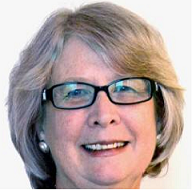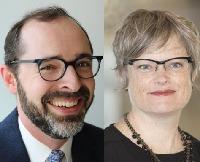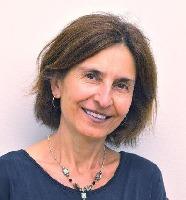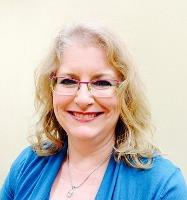DPC
Thinking Creatively to Understand Complexity: A Workshop for the UK Legal Deposit Libraries’ Emerging Formats Project
Caylin Smith is the Legal Deposit Libraries Senior Project Manager for the British Library
Earlier this month, the British Library hosted a workshop for the Legal Deposit Libraries’ Emerging Formats project. The purpose of the workshop was to engage stakeholders and look at some new approaches to address challenges the project has identified.
In this post, Caylin Smith, project manager for the Legal Deposit Libraries and a researcher on the Emerging Formats project, outlines the importance of Non-Print Legal Deposit in the UK, provides background information on the Emerging Formats project and in-scope content, as well as introduces the workshop.
Sara Day Thomson of the DPC then describes her experience of the workshop and how the Emerging Formats project reflects broader trends in digital preservation.
Against Entropy: An Update
Sheila Morrissey is Senior Researcher at Ithaka S+R, based in New York
If there’s one thing digital preservationists understand, it’s the importance of continual investment in infrastructure. That includes our own technical infrastructure – the systems we rely on to collect and manage and deliver digital objects over the very long term.
On the first World Digital Preservation Day, we were just at the mid-point of a two-year project to rebuild Portico’s technical preservation infrastructure, pretty much from the ground up. At the end of September of this year, we closed out our “NextGen” project as scheduled.
As we noted in last year’s WDPD day of blogging, a big motivation for our “gut rehab” project was the need to grapple with issues of scale – with geometric growth across pretty nearly every measure of content streaming into the Portico archive:
Sustaining your own Digital Preservation Efforts
Nancy McGovern is Director of Digital Preservation at MIT Libraries
I love what I do! My role combines research, instruction, and practice and has since I started at Cornell as the Digital Preservation Officer in 2006 - that means by design I never have to stop doing what I am doing to work on what I want to do, which is amazing.
Recap of Born to Be 3D Forum Hosted by the Library of Congress
Kate Murray and Jesse Johnston are B2B3D Program Coordinators and work at the Library of Congress in Wasghington DC, USA
On November 2, 2018, the Library of Congress hosted Born to Be 3D: Digital Stewardship of Intrinsic 3D Data (#B2B3D), a small group forum to discuss stewardship of born digital 3D data. Born-digital 3D content is an emerging research and technology area. Digital preservation approaches and stewardship requirements for this content are not yet mainstream, but the impact and influence of this content is undeniable. In its role as a convener, the Library’s goal for sponsoring B2B3D is to support and amplify existing research projects while also bringing together a “sampler” of 3D-related development across a wide spectrum of stakeholders. The publication of the Library’s new Digital Strategy with renewed focus on driving momentum in our communities and building towards the horizon made this the ideal opportunity to engage in the building energy in the well-named Year of 3D.
Preservation Rights
Jared Lyle is an Archivist at the Inter-university Consortium for Political and Social Research (ICPSR), where he directs the Metadata and Preservation Unit which is responsible for Metadata, the Bibliography of Data-Related Literature and Digital Preservation. He also serves as Director of the Data Documentation Initiative (DDI), an international metadata standard for describing survey and other social science data.
While my thoughts about digital preservation tend to gravitate to issues of file format longevity, on the occasion of this World Digital Preservation Day I've been thinking quite a bit about preservation rights, especially from the perspective of a data custodian. Why the recent shift in concentration? The repository where I work, ICPSR, a data repository for social and behavioral science data, has applied for the CoreTrustSeal Data Repository certification. ICPSR has participated in several repository audits and certifications. In 2006, it was a test case for Trusted Repositories Audit & Certification (TRAC). ICPSR was one of the first six data repositories to earn the Data Seal of Approval in 2011. ICPSR earned the World Data System certification in 2013. CoreTrustSeal Data Repository certification replaces the DSA certification and WDS Regular Members certification.
Designing a Universal Virtual Interactor (UVI) for digital objects
Euan Cochrane is Digital Preservation Manager at Yale University Library
In the EaaSI program of work we're developing the ability to click on a link to a digital object (for example in a library’s catalogue or an archival finding aid) and have it "automagically" open in a representative version of the “original” software, within your web browser, using an emulator. For example, the gif below demonstrates clicking a link to automatically open a Microsoft Works file running in Windows 98 within a web browser[1].
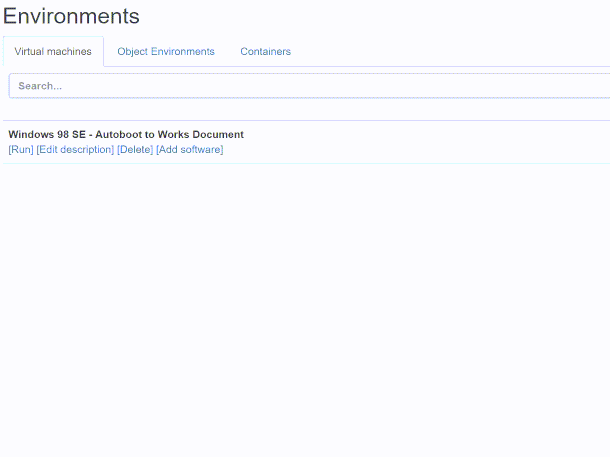
Audiovisual archives & digital preservation
Bertram Lyons is Senior Consultant for AVP
I want to tell a story to demonstrate the inherent relationship between audiovisual preservation and digital preservation.
1. What is it about audiovisual preservation today that requires us to engage in digital preservation?
My story begins with a collection of folk music analog audio recordings in the Alan Lomax Archive.
The year is 2002. The recordings -- I’ll focus on the 2,000 quarter-inch magnetic reel to reel audio tapes -- date from 1948 to 1997. They vary in composition from paper, to acetate, to polyester. They display a variety of states of physical condition, from excellent, to disheveled, to disintegrating, to sticky.
Cloud-Enabled Preservation of Life in the 20th Century White House
Stephanie Tuszynski is Director of the White House Historical Association Digital Library in Washington DC, USA
The White House Historical Association was founded in 1961 to "enhance the understanding and appreciation" of the White House by offering educational resources to students, teachers, scholars, and the general public to help them learn about the building and its history. The WHHA Digital Library is a key piece of our outreach strategy, with more than 10,000 images and documents in our growing collection available to the public for free at whha.org/library.
The "Cloud-Enabled Preservation of Life in the 20th Century White House" project is making previously-inaccessible images of the White House available for the first time. The Association has thousands of photos covering public and private events at the White House from the Kennedy era through the current administration, which we are adding to the Digital Library with the help of Amazon Rekognition (a cloud-based facial recognition technology) in the processing of our collections, and by using Amazon Glacier cloud storage for the long-term preservation of these materials.
Perspectives on the Evolving Ecology of Digital Preservation
Oya Y. Rieger is Senior Advisor at Ithaka S+R, based in New York
As an organization that provides research and consultancy services to the global higher education community to support the creation, discovery, dissemination, and preservation of scholarship, Ithaka S+R is interested in exploring the current landscape of digital preservation programs and services in order to identify research questions that will contribute to the advancement of strategies in support of future scholarship. To this end, we recently published a brief, The State of Digital Preservation in 2018: A Snapshot of Challenges and Gaps, which is based on interviews with 21 experts and thought leaders to survey their perspectives on the state of digital preservation. The digital preservation community now represents deeper expertise involving a robust exchange of best practices, standards, preservation techniques, tools, and systems. Nevertheless, given the complexity of designing preservation strategies at scale, it is inevitable that there is lingering anxiety.
PDFS: When a Standard isn’t Standard in your Collections
Leslie Johnston is Director of Digital Preservation at the U.S. National Archives and Records Administration (NARA) in Washington DC, USA
In 2017 the DPC announced its “Bit List” of Digitally Endangered Species as a crowd-sourcing exercise to discover which digital materials our community thinks are most at risk, as well as those which are relatively safe thanks to digital preservation. The “Items of Concern” portion of the list included PDF, a format bearing some discussion and use cases.
Let’s start with a number - the U.S. National Archives and Records Administration (NARA) has over 10.2 million PDFs in its holdings. In a collection of close to 1.5 billion files, that doesn't seem like a significant file management challenge, until one digs deeper into the data.
During 2017, NARA created a Holdings Profile: see my blog post for World Digital Preservation Day 2017 for an introduction to that work. The outcome was an analysis of what formats NARA has in the holdings. It’s inevitably not perfect, as there are always levels of uncertainty involved in assessing file formats, especially when an organization has been accepting a wide variety for formats for 50 years. There are different levels of tooling in place for different portions of the holdings housed in different preservation systems, something that will be gradually rectified as we migrate records into the new ERA 2.0 system.
































































































































